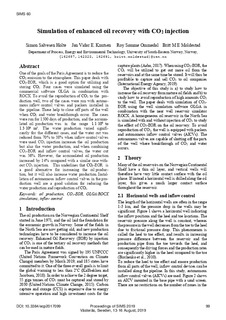| dc.contributor.author | Holte, Simon Salvesen | |
| dc.contributor.author | Knutsen, Jan Vidar E. | |
| dc.contributor.author | Ommedal, Roy Sømme | |
| dc.contributor.author | Moldestad, Britt Margrethe Emilie | |
| dc.date.accessioned | 2020-02-05T09:06:45Z | |
| dc.date.available | 2020-02-05T09:06:45Z | |
| dc.date.created | 2020-01-31T09:54:00Z | |
| dc.date.issued | 2019 | |
| dc.identifier.citation | Linköping Electronic Conference Proceedings. 2019, 170, 99-105. | nb_NO |
| dc.identifier.issn | 1650-3686 | |
| dc.identifier.uri | http://hdl.handle.net/11250/2639707 | |
| dc.description.abstract | One of the goals of the Paris Agreement is to reduce the CO2 emission to the atmosphere. This paper deals with CO2-EOR, which is a good option for utilizing and storing CO2. Four cases were simulated using the commercial software OLGA in combination with ROCX. To avoid the reproduction of CO2 to the production well, two of the cases were run with autonomous inflow control valves and packers installed in the pipeline. These help to close off parts of the well when CO2 and water breakthrough occur. The cases were run for 1500 days of production, and the accumulated oil production was in the range 1.1·106 to 1.3·106 m3. The water production varied significantly for the different cases, and the water cut was reduced from 70% to 38% when inflow control valves were used. CO2 injection increases the oil production but also the water production, and when combining CO2-EOR and inflow control valves, the water cut was 56%. However, the accumulated oil production increased by 14% compared with a similar case without CO2 injection. This underlines that CO2-EOR is a good alternative for increasing the oil production, but it will also increase water production. Installation of autonomous inflow control valves in the production well are a good solution for reducing the water production and reproduction of CO2. | nb_NO |
| dc.language.iso | eng | nb_NO |
| dc.rights | Navngivelse-Ikkekommersiell 4.0 Internasjonal | * |
| dc.rights.uri | http://creativecommons.org/licenses/by-nc/4.0/deed.no | * |
| dc.title | Simulation of enhanced oil recovery with CO2 injection | nb_NO |
| dc.type | Journal article | nb_NO |
| dc.type | Peer reviewed | nb_NO |
| dc.description.version | publishedVersion | nb_NO |
| dc.source.pagenumber | 99-105 | nb_NO |
| dc.source.volume | 170 | nb_NO |
| dc.source.journal | Linköping Electronic Conference Proceedings | nb_NO |
| dc.identifier.cristin | 1787642 | |
| cristin.unitcode | 222,58,3,0 | |
| cristin.unitname | Institutt for prosess-, energi- og miljøteknologi | |
| cristin.ispublished | true | |
| cristin.fulltext | postprint | |
| cristin.qualitycode | 1 | |

